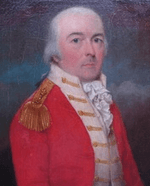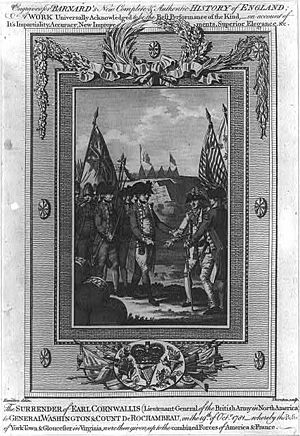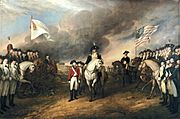Charles O'Hara facts for kids
Quick facts for kids
Charles O'Hara
|
|
|---|---|

Portrait of O'Hara, c. 1791
|
|
| Born | 1740 Lisbon, Portugal |
| Died | 25 February 1802 (aged 61–62) Gibraltar |
| Allegiance | |
| Service/ |
British Army |
| Rank | General |
| Battles/wars | |
Charles O'Hara (1740 – 25 February 1802) was a British military officer. He was a general in the British Army. O'Hara fought in several major wars. These included the Seven Years' War and the American Revolutionary War. He also fought in the French Revolutionary Wars. Later, he became the Governor of Gibraltar.
During his long career, O'Hara had a unique experience. He personally surrendered to two famous leaders. These were George Washington and Napoleon Bonaparte.
Contents
Early Life
Charles O'Hara was born in Lisbon, Portugal, in 1740. His father was The 2nd Baron Tyrawley. His father later became a Field Marshal in 1763. Charles went to Westminster School in England.
He started his military career very young. On 23 December 1752, at age twelve, he became a cornet. This was a junior officer rank. He joined the 3rd Dragoons. By 1756, he was a lieutenant in the Coldstream Guards. This was just before a big war started in Europe.
Seven Years' War
The Seven Years' War was a global conflict. O'Hara served in Germany during this war. He was an aide to the Marquess of Granby. Granby was a senior British officer. He served with the army of the Duke Ferdinand of Brunswick.
In 1762, O'Hara also served in Portugal. He was under his father's command. He also saw action in Germany. O'Hara was known for being strict. But his soldiers liked him very much.
American Revolutionary War
In July 1778, Lieutenant Colonel O'Hara arrived in America. He immediately took command of forces. This was at Sandy Hook, New Jersey. The French fleet was threatening New York City. So, General Henry Clinton gave O'Hara this important job. Clinton was the British army commander in America.
Southern Campaign
In October 1780, O'Hara was promoted to brigadier. He became the commander of the Brigade of Guards. He also became second-in-command to Lieutenant General Charles Cornwallis. They became good friends.
O'Hara showed great bravery in battle. He fought well at Cowan's Ford in North Carolina. This was on 1 February 1781. He also led a British counterattack. This happened at the Battle of Guilford Court House on 15 March 1781. General Nathanael Greene's army had to retreat. O'Hara was badly hurt in this battle. But he stayed with the army as they moved to Yorktown. His nephew, an artillery officer, was killed during the battle.
Yorktown
The Siege of Yorktown was a very important battle. It took place on 19 October 1781. General O'Hara represented the British during the surrender. Lord Cornwallis, the British commander, said he was too ill. O'Hara first tried to surrender to the French commander, Comte de Rochambeau. But Rochambeau refused the sword. He said O'Hara should surrender to General George Washington.
Washington also refused the sword. He told O'Hara to surrender to Benjamin Lincoln. Lincoln was Washington's second-in-command. Lincoln had surrendered to the British earlier in Charleston, South Carolina. O'Hara was later exchanged for another prisoner. This happened on 9 February 1782. He was sent to the Caribbean with more troops. After the war ended with the Treaty of Paris, he returned to Britain. He had been promoted to major general.
The Sword of Surrender
There are different stories about what happened to the surrender sword. Some say General Washington kept it for a few years. Then he returned it to Lord Cornwallis. Others believe the sword is still in America. Perhaps it is in the White House.
However, a modern study of the Yorktown campaign gives a clear account. Historian Jerome S. Greene wrote about it in "The Guns of Independence" (2005). He states that O'Hara offered Cornwallis's sword. Washington took the sword for a moment. Then he gave it back to O'Hara. This means the sword stayed with its original owner.
After the War
In 1784, O'Hara left England. He traveled to Europe. He had some financial difficulties. While in Italy, he met the writer Mary Berry. They started a long friendship. Lord Cornwallis helped him with his financial problems. This allowed O'Hara to return to Britain.
In 1786, Cornwallis became the Governor-General of India. He offered O'Hara a position there. But O'Hara chose not to go. In 1792, he was appointed lieutenant governor of Gibraltar.
Toulon
In 1793, O'Hara was promoted to lieutenant-general. On 23 November 1793, he was captured in Toulon, France. This happened during a battle where Napoleon first gained attention. O'Hara was leading a brave attack by British troops. Napoleon himself directed the capture. He personally accepted O'Hara's surrender.
O'Hara was held as a prisoner. He spent two years in a prison in Paris. While there, he became friends with Thomas Paine. Paine was an American revolutionary.
So, O'Hara has a unique record. He was personally captured by both George Washington and Napoleon Bonaparte.
Later Years
In August 1795, O'Hara was exchanged for Comte de Rochambeau. Later that year, he became engaged to Mary Berry. But the engagement ended. He was named Governor of Gibraltar for a second time. This happened on 30 December 1795. Mary Berry did not want to leave England.
He was promoted to full general in 1798. O'Hara is also known for O'Hara's Tower on Gibraltar. He had discussions with John Jervis, 1st Earl of St Vincent about redesigning Gibraltar. This was to help the British Fleet.
Charles O'Hara died on 25 February 1802. He passed away from problems related to his old war wounds.
In Popular Culture
Charles O'Hara has been shown in movies. In the 2000 film The Patriot, he was played by Peter Woodward. The film starred Mel Gibson.



